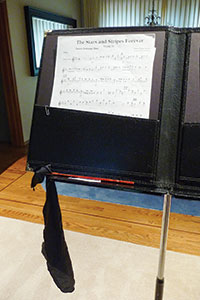Sarah Jackson, piccolo of the Los Angeles Philharmonic, presented a masterclass last October for the Greater Portland Flute Society. This article is based on a compilation of the topics in that masterclass and a conversation with her.
The masterclass focused on practice techniques designed to develop a resonant, warm, and rich piccolo sound while keeping the body relaxed and open. In addition, she discussed hearing protection, suggestions for swabbing the piccolo, and advice for assembling flutes. Although the class primarily discussed piccolo, many of the ideas are applicable to flute as well.
.jpg)
Tone Production – Relaxation is Key
When placing the piccolo in playing position, it should sit higher on the lip than the flute and the headjoint should not be rolled in too far. If the headjoint is rolled in, too much of the embouchure hole will be covered, which will squash the sound. The exact position will vary depending on the shape and size of the lower lip, and some experimentation will be required to get the best sound.
The piccolo sounds its best when the player is relaxed enough to create resonance within the body. The ability to open up and be relaxed is essential to developing good piccolo tone. Players should avoid the tendency to tighten the embouchure because the piccolo is small. A tight embouchure causes tension in the body, particularly in the throat. The piccolo, as well as the flute, does not respond to aggression. The instrument cannot be forced to sound good.
Unfortunately, the human body is not designed to spontaneously relax. Players should practice relaxing, just as they work on good finger technique. It should occur over time – from the beginning to the end of a warm-up, from one day to the next, or over the course of a week or a year.
Before beginning a practice session, take a full breath to open the lungs. This is crucial to a dark sound, whether preparing to play a long note or short note. It helps add lower harmonics to create a warm rich sound that will project and be pleasing to the ear. Jackson commented, “I like to take a full breath even if I am playing only one staccato eighth note.”
Next, make sure the throat is open. She advised, “Open the throat in two ways: making it wider and making it taller. Making the throat taller is accomplished by raising the soft pallet (like a yawn) in conjunction with lowering the back of the tongue. When doing this, the jaw drops a bit, too.”
Now, relax the lips, or embouchure. This allows the lower harmonics to resonate. The piccolo needs only a slightly smaller aperture than the flute, but one that is not too small or tight. Make sure that all of the effort to relax and open up in order to produce a rich sound is not negated by a tight embouchure.
Slow Practice
When working on tone, practice slowly. (See Jackson’s Piccolo Warm-Up #1) Work on finding the sweet spot of every note to develop a beautiful sound that has low harmonics. The higher the tessitura, the more air is needed to find the sweet spot and to support the sound. Since more air is needed, the higher notes may have a louder dynamic. This is not the time to think about playing quieter in the high register or louder in the low register.
Developing a Blending Sound
Try to make changes in the tone color to blend better with other instruments such as the oboe or the Eb clarinet. Anticipate the tone color of instruments and add lower harmonics. Use the embouchure to alter the pitch and tone color. Tone color can also be changed by changing the shape inside the mouth as well as the position of the tongue with various vowel sounds.
Frequently, pitch issues with other instruments are more about blend than intonation. Changing the tone color to one that blends better may entirely fix or at least improve the intonation problem. Just changing the pitch and not the tone color can narrow the embouchure, leading to a thinner sound that can worsen the problem.
Other Tips
Jackson had some important advice for safely assembling and disassembling a flute. Hold the barrel of the flute with one hand, and the tube of the headjoint (not the lip plate) with the other hand. Avoid grasping the keys or the lip plate. Grasping the lip plate can weaken the solder where the lip plate is attached to the tube, causing micro cracks. This can weaken the solder to a point where the lip plate becomes detached from the tube. If this happens, the headjoint will never be the same again.
She also highly recommends wearing earplugs when playing piccolo or playing in a loud ensemble. She also wears earplugs for extended flute playing in the third octave. As a musician, it is tremendously important to do whatever you can to protect your hearing.
* * *
Sarah Jackson has held the position of piccolo of the Los Angeles Philharmonic since 2003. Prior to that, she was assistant principal flute and piccolo with the Vancouver Symphony Orchestra in British Columbia, Canada. She has taught flute and piccolo at the University of British Columbia and has presented masterclasses and recitals in Italy, Japan, France, United Kingdom, Czech Republic, Belgium, Nether-lands, Venezuela, Hong Kong, Canada, and the United States.
* * *
Sarah Jackson’s Piccolo Warm-Up #1
The goal of this exercise is to warm up as well as improve tone and sound production. As you play the exercise, challenge yourself to become more and more relaxed and open.
1. Begin by taking a full breath and open the throat. Maintain the openness in the body to put more low harmonics in the sound and maintain good tone quality. The higher in the tessitura, the more air is needed to use to find the sweet spot. Since more air is needed, the higher notes may have a loud dynamic. Do not worry about playing quieter in the high register or louder in the low register.
2. Practice this exercise very slowly. This is a tone exercise. Find the sweet spot of every note and develop a beautiful sound that contains more low harmonics.
3. Markings show the quantity of air to use. The crescendo and diminuendo markings are not dynamic changes, but a visual representation of the quantity of air being used. The higher the tessitura, the more air is needed to support the sound.
4. Breathe after every measure.
5. Start the exercise on line 4 (F major). This exercise should not be started on the first line, as the low D is not the easiest note on piccolo. Since the exercise is very slow, you will not be able to practice all the keys in one day. However, make sure you work on all three registers daily. For example, start on F1, then Eb1, move on to G1, A1, etc. playing every other key The next day, alternate the keys not played the day before.
MUS-1.jpg)
MUS-2.jpg)
* * *
Swabbing Tips
Jackson recommends using a wooden or plastic cleaning rod to swab the piccolo, as a metal rod might scratch the inside of the instrument. She uses a teardrop-shaped silk cloth, but cuts one side of it off, so it is not too bulky to pull through the piccolo, but has enough fabric to absorb the moisture.
She quickly swabs the moisture out of her instrument during a concert by taking off the headjoint and dropping the cleaning rod, threaded with a silk cloth, into the tenon end of the piccolo. She pushes the rod through, pulling it out the other end so the cloth can absorb the moisture. She then wraps the silk around the rod and swabs the inside of the headjoint.
She then quickly reassembles the piccolo, matching an alignment mark she has made on the metal of the headjoint tenon with the point of the metal rib at the base of the keys. (A spot of dark nail polish will last much longer than a mark made with a fine point permanent marker.)
After swabbing, she slides the solid end of the rod onto the music stand behind her music so the silk is hanging like a banner off the edge of the stand. This allows the silk to dry out between swabbing sessions.

After playing, she uses a piccolo flag-type swab to remove any residual moisture from the crown end of the headjoint. She does not use this type of swab for regular swabbing of the body as she feels that swabbing quickly is more likely to sweep water into the tone holes than to completely remove it from the instrument. To remove all of the moisture from the piccolo, the piccolo flag should be turned while it is slowly pulled through the instrument, removing the moisture out the end of the piccolo.






